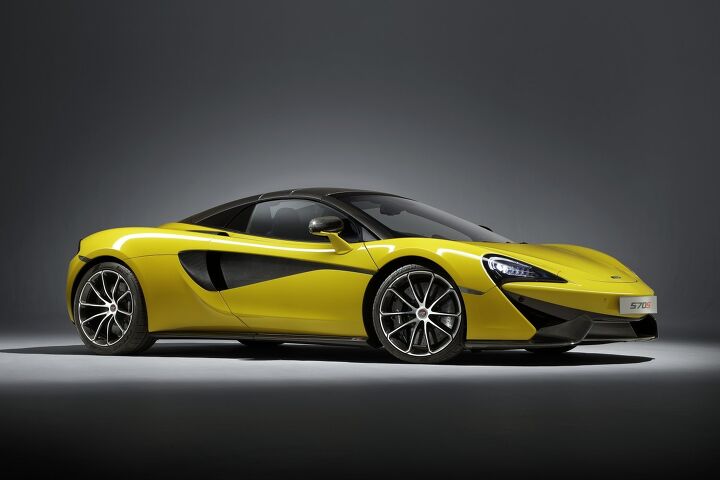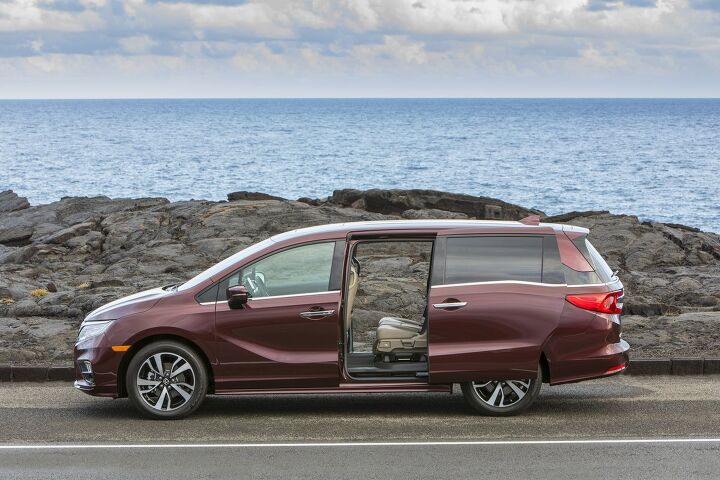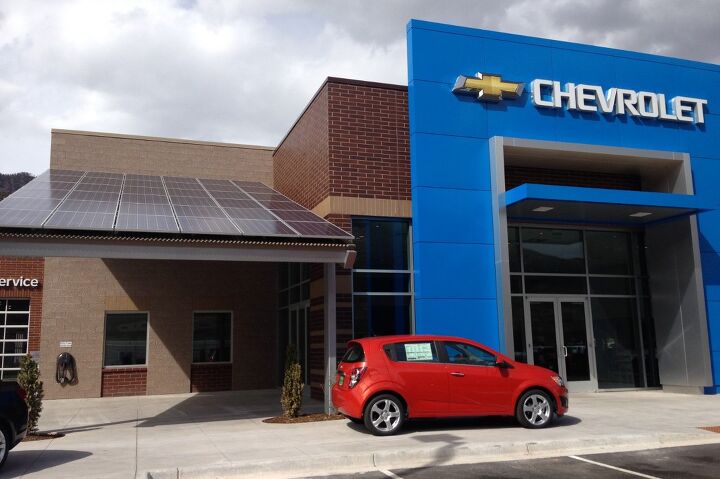#AutoSales
General Motors, Ford, Fiat Chrysler Automobiles All Suffer Big U.S. Sales Drops in July
As U.S. auto sales are forecasted to fall between 5 and 6 percent in July 2017, the reports released this morning by the traditional Detroit Three — General Motors, Ford Motor Company, Fiat Chrysler Automobiles — appear to be worse than average.
Due to decreased year-over-year volume at each of its four brands, including a harsh 30-percent decrease at Buick, General Motors plunged 15 percent to 226,107 sales. That loss equalled 41,151 fewer sales for America’s largest automobile seller. At Ford Motor Company, total sales fell 7 percent despite rising F-Series sales. Car volume tumbled 19 percent at Ford and Lincoln, and SUV/crossover sales were up only slightly. At FCA, meanwhile, a 10-percent overall decline was caused by decreased volume at Jeep, Chrysler, Dodge, and Fiat.
Fortunately, there remain reasons for optimism.
Forecasters Believe July 2017 Was the U.S. Auto Industry's Seventh Consecutive Month of Decline
Despite all of the attention being called to the U.S. auto industry’s downturn in early 2017, first-half auto sales slipped only 2 percent from 2016’s all-time record highs.
But the rate of decline in July 2017 is expected to be the worst of the year so far, with forecasters generally calling for drops of at least 5 percent.
That will represent a loss of at least 76,000 sales in July alone.
America's 20 Top-Selling Vehicles That Aren't Pickup Trucks in 2017's First Half
Cars are not at the top of the heap.
In fact, not since 2013, when the Toyota Camry was America’s third-best-selling new vehicle, has a passenger car claimed a podium position on the U.S. automotive sales leaderboard. Fast forward to 2017 and passenger cars are way down the list of America’s top-selling new vehicles.
With pickup trucks so obviously differentiated from conventional consumer-oriented vehicles, and with the top-selling trio of pickup trucks (Ford F-Series, Chevrolet Silverado, Ram P/U) so distinctly more common, we’ve compiled this list of America’s 20 top-selling vehicles that aren’t pickup trucks, a halfway measuring stick that shows which vehicles are the dominant market forces through 2017’s first six months. Not including the pickup trucks that own 16 percent of the industry, of course.
The top-ranked nameplate deserves an asterisk — an asterisk that will grow in size over the coming months. And cars? Even with pickup trucks excluded, they miss the podium altogether.
Toyota Turning Toward Rental Fleets and the RAV4 to Boost Volume
We’re beginning to pummel a dying horse here but, as you already know, the North American automotive market is shrinking right now. Toyota wants to mitigate this by funneling sales into rental fleets. While this tactic has become unpopular with automakers like General Motors, others have bolstered fleet sales to cope with the lackluster demand. Hyundai, for example, has relied heavily on rental companies to boost its total volume, but the move has placed dealerships and the corporate office at odds with each other.
Toyota’s U.S. deliveries fell 3.6 percent through June of this year, which is 1.5 percent ahead of the industry’s overall decline. The automaker wants to fill the gap by ramping up volume to rental companies before the end of 2017. Like Hyundai, Toyota’s best sellers are passenger cars — which have taken the brunt of consumer apathy of late — but knows it can still unload them on Enterprise, Avis, and Hertz.
U.S. Auto Sales Brand-By-Brand Results: June 2017 YTD
Auto sales slid 3 percent in the United States in June 2017, marking the end to a first-half of 2017 in which U.S. auto sales declined in six consecutive months.
Despite Acura-fuelled improvements at American Honda, RAV4-powered increases at Toyota, Volkswagen’s continued bounce-back from the brink, a 6-percent jump in full-size pickup truck sales, and modest gains at a number of America’s top-selling premium brands, June volume fell by roughly 45,000 units, year-over-year.
June wasn’t a horrible month for auto sales in America, just as the first-half of 2017 was not a dreadful stretch. The comparison with 2016, a record year for auto sales in America, causes 2017 to appear worse than it really is.
June 2017 U.S. Auto Sales Likely Slid for a Sixth Consecutive Month As Incentives and Transaction Prices Rise
Automakers likely sold fewer than 1.5 million new vehicles in the United States in June 2017, a modest decrease of around 2 percent compared with June 2016.
While auto sales remain high by historic standards — 1.48 million sales would still make June 2017 more than 15-percent better than the 1.33 million June average from 2011-2015 — June nevertheless represents the persistence of a negative trend.
After 2016 ended with a December boom to close out the highest-volume year on record, auto sales in the United States declined on a year-over-year basis in each of 2017’s first five months. A 2-percent drop in June, worth roughly 30,000 lost sales, will run the streak of decreases to a full half-year.
The American auto industry’s decline comes as automakers continue to incentivize heavily and, fortunately for manufacturers, consumers grow ever more willing to pay higher prices.
McLaren Automotive Sales and Profits Are Soaring; 2017 Expected to Be Even Better Than 2016
SUVs aren’t the only means of success in the global auto industry in 2017.
Sports cars, supercars even, appear to be a useful means of sourcing profits, even for a relatively young automaker such as McLaren.
It’s often said that the one way to make a small fortune racing cars is to start with a large fortune. The theme is just as accurate when it comes to automotive production and sales.
Yet McLaren, which began series production of road cars only seven years ago, saw its profits jump 70 percent, year-over-year, to USD $12 million in 2016 as global sales doubled.
More than one-third of the McLarens sold in 2016 are found driveways in North America.
General Motors' 2017 U.S. Auto Sales Forecast Adjusted (Downward)
General Motors no longer expects the U.S. auto industry to collect more than 17.5 million new vehicle sales in 2017.
GM’s chief financial officer, Chuck Stevens, revisited the automaker’s U.S. sales forecast and turned the wick down from the mid-17-million-unit range, according to Automotive News, to the low-17-million-unit range.
That’s not a low number. In fact, 2017’s reduction of some 300,000 sales across the industry, year-over-year, would produce the second-best year for auto sales since 2001.
But reduced demand is complicating matters for the entire industry, most particularly for large automakers with excessive inventory.
After a Dreadful Start, 2017's Second Half Is the Minivan's Time To Shine - but Can the Segment Recover?
The 2018 Honda Odyssey went on sale three weeks ago. The Chrysler Pacifica has only been on the market for a year. The Toyota Sienna will enjoy another refresh for the 2018 model year.
If ever there was a time in which America’s minivan segment needs to shine, the second-half of 2017 is it.
Minivan sales tumbled 14 percent, year-over-year, through the first five months of 2017. Only 3 percent of the auto industry’s volume is now minivan-derived. Year-over-year volume decreased in nine consecutive months between August 2016 and April 2017.
There are far fewer competitors now than there were a decade ago. Therefore, the minivan market doesn’t need to produce the sort of volume it did a decade ago. However, minivan sales can’t continue to plummet, month after month after month.
Minivan sales need to rise. If they can’t do so now, then when? And if the segment can’t do it with fresh product from Chrysler, Honda, and Toyota, then who can supply the growth?
The Ford Mustang's New Big Market: Australia
Thanks to the appeal of a modern independent rear suspension and the availability of right-hand drive, the sixth-generation Ford Mustang has encountered far greater global appeal than any Mustang before it.
The latest country to take a real liking to the Mustang is Down Under, where Australians are buying more Mustangs than any other Ford save the Ranger.
And it’s a good thing they are. While U.S. sales of Mustang plunged 28 percent in the first five months of 2017, production at Mustang’s Flat Rock, Michigan, assembly plant hasn’t been forced to slow down nearly that much. Through the first-third of 2017, Ford built only 4-percent fewer Mustangs than in the same period last year.
Put another Mustang on the barbie, indeed.
With Mostly American Support, Subaru Claims Global All-Wheel-Drive Sales Supremacy, Stomps On Quattro
No auto brand in the world sells more all-wheel-drive vehicles than Subaru, says Subaru.
Autocar is reporting figures from Subaru UK that say 15 percent of the global market for all-wheel-drive vehicles is scooped up by the Subaru brand.
In Subaru’s fiscal year from April 2015 to April 2016, the automaker finished with nearly 1 million sales of all-wheel drive vehicles — 245,382 more than the next-highest-volume all-wheel-drive provider: Audi.
American Honda Expects Facelifted 2018 Acura TLX to Sell Better Than Ever
Upon its debut in late 2014, the Acura TLX had big shoes to fill. Not only was the TLX intended to replace the Acura TL, the TLX would also serve, at least in part, as a replacement for the Acura TSX.
Not surprisingly, the TLX never sold as often as that duo did at their peak. Acura sold over 113,000 TLs and TSXs in 2005. Yet by the end of their run, in 2013, Acura managed to sell fewer than 42,000 TLs and TSXs. As a result, the arrival of the Acura TLX — and yes, it’s difficult for both reader and writer to keep the letters straight — was heartily welcomed by Acura dealers. The TLX represented a simpler lineup, one sufficiently spacious car, and 47,080 sales in 2015.
But TLX sales have trailed off rather precipitously ever since, and Acura is counting on a thorough refresh for the 2018 model year to spur TLX demand once again.
And quite a spur it must be. Wards Auto is reporting that Acura’s goals for the facelifted TLX are loftier than ever.
2017 U.S. Auto Sales Forecasts Are Falling; Still Likely the Fourth-Best Year on Record
After U.S. sales of new vehicles declined 2 percent, year-over-year, through the first five months of 2017, forecasters surveyed by Bloomberg are largely in agreement. 2017 will fall well short of 2016’s record auto industry output, sliding to 17.2 million sales from more than 17.5 million in 2016.
There are nevertheless a handful of positives on which optimistic automakers can draw. First, a 17-million-unit sales year still represents a huge number of sales for manufacturers that averaged 12.5 million sales between 2008 and 2012.
Second, the high incentive spending doesn’t appear to be growing higher. Pair that with high average transaction prices and automakers can still earn big profits.
Third, if Washington ever does get around to legislating — no sure bet in this investigative congressional age — then promised tax cuts and infrastructure programs could further elevate demand.
In the meantime, there are causes for concern.
Vanishing Act: America's 10 Most Rapidly Declining New Vehicles in 2017
The U.S. auto industry is shrinking. But only by a little bit.
Auto sales through the first five months of 2017 are down just 2 percent, a drop of roughly 140,000 sales across the entire industry. Aside from high inventories and rising incentives, it’s not all doom and gloom. 2016 was the highest-volume year in the history of the American auto industry — a 2-percent drop is hardly catastrophic.
This is therefore not 2009, when virtually every new vehicle suffered decreased volume. Many new vehicles are surging, selling significantly more often this year than last.
But in a declining market, many other nameplates are in fact losing sales. Many sales. We’ve compiled a list of the 10 volume nameplates losing U.S. sales most rapidly.
Canadian Auto Sales More Numerous Than Ever in May 2017; Canadians Paid More Than Ever, Too
Canadian auto sales surged to record levels in May 2017, surpassing the previous monthly record from April of last year by an 8-percent margin and topping 200,000 units for just the second time in history.
You know it’s going well when, in a virulently anti-car market, passenger car sales increase, year-over-year. And in the fifth month of 2017, car sales did indeed improve, growing 3 percent beyond May 2016 levels.
You know it’s truly going well when, in a market that had already seen pickup truck market share climb to 20 percent, pickup truck sales jumped 38 percent to form 22 percent of the industry’s volume.
And you know it’s going exceptionally well when, in the span of just one month, the relatively small Canadian market purchases and leases 217,000 new vehicles at significantly higher prices than in the past.






























Recent Comments